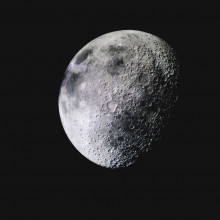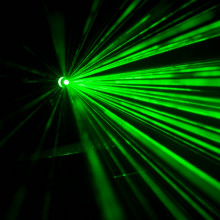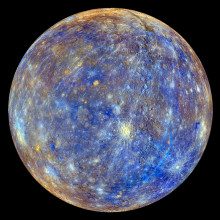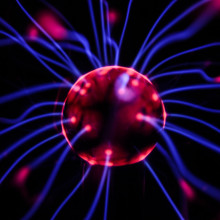QnA: Sperm Races and Monkey Business
This week, can science help us to quit our vices? Do any animals have accents? And how big can a planet get? Joining Chris Smith to tackle your sci-curious questions was physicist Jess Wade, planetary geologist David Rothery, neuroscientist Bianca Jupp and zoologist Jacob Dunn.
In this episode

05:15 - Could life exist on a moon?
Could life exist on a moon?
Chris Smith put this question from listener Sarah to planetary geologist David Rothery from the Open University. Plus animal behaviour expert, Jacob Dunn, had another question for David.
David - Well, in this solar system, Sarah, moons are probably the best place to go looking for life. You shouldn’t restrict your imagination of where life can exist to the surface of a body with a blanket of air like planet Earth.
We think life on Earth began at the interface between warm rock and salty water - the floors of the oceans. And we have at least two moons, one of Jupiter and one of Saturn, where we’ve got oceans sitting on top of tardily heated rock with a possibility of chemical reactions between the water and the rock, and that’s the setting where life could exist today.
If you took the right microbes from the Earth and put them under the ice on Europa and Enceladus, life could hang on there - it could exists. So, the question is did life ever get started there on it’s own, and that’s what we don’t know. But we know from the recent Cassini mission to Saturn that flew through the plumes from Enceladus where the ice is jetted to space. It’s got all the ingredients; it’s got organic molecules; tiny rock particles; molecular hydrogen, there is a metabolic pathway feasible on the floor of Enceladus’ ocean.
So yes, life in the internal oceans of moons, very much a thing to look for.
Chris - Jacob?
Jacob - This is probably a naive question, but would we know what we were looking for? Would we know what life looked like?
David - Well, life is anything that will reproduce, to undergo a Darwinian evolution, and piggyback on chemical reactions. If we can see an atmosphere or ocean chemistry that’s kept out of equilibrium we tend to suspect that it’s because of living processes. But difficult, I agree.
Jacob - I just wonder if we might see some of the sort of early reactions that aren’t life per se, but maybe they kind of precursor of what we know?
Chris - That’s a good question. Can we get clues as to how life got started on Earth in these places?
David - The fact is there are so many organic molecules around in the cosmos which are not the products of life, but you’ve got simple amino acids which exist already. So if you want to find something that says “life did this”, you’ve got to look for more and more complex molecules. I think we need to see the chemistry in action. And I guess if we ever do find what might be a biosphere, pinning down whether it’s due to living processes or something that’s not quite living might be difficult.
Chris - So Sarah, the bottom line is that these moons could play home to life, it’s just where or not it’s got started yet.

07:56 - Do animals have different vocal ranges?
Do animals have different vocal ranges?
Joanne called the show and had this question for animal communication expert Jacob Dunn from Anglia Ruskin University.
Jacob - Hi Joanne. That’s a really good question. There is obviously a difference in the frequency in the voice in humans as you rightly say, so male voices tend to be about 75 percent lower frequency than female voices. Interestingly, this is something that, as we all know, doesn’t happen all the way throughout our lives.
In other animals - I know most about primates - but it’s true in some other animals as well. Whether there is a difference or not between males and females seems to be related to the mating system. So in those mating systems where males compete more ferociously for access to females and have harem groups and so on, there tends to be a more exaggerated difference between the males and the females. And in other species that are perhaps monogamous, and there’s not such high levels of competition between the males, then the difference between the males and females tends to be less.
So in answer to Joanne’s question yes, we do see this in other species and it seems to be linked to the competition between the males, and the mating system.
Chris - Happy with that Joanne?
Joanne - Yes. But in those cases, is there evidence of it changing during the animal’s lifetime like it does in the humans then?
Jacob - Yeah. Again that’s a really good question. And yes is the answer through the same mechanism. The reason that the voice frequency drops in male humans is because it’s linked to testosterone. The vocal folds, as they lengthen, anything bigger vibrates at a lower frequency so as you get longer vocal folds, your vocal frequency gets lower and, therefore, you have a lower pitched voice. And that growth in the vocal folds in boys and in the male voice is linked to testosterone. And through that same mechanism in other animals as they get higher testosterone their vocal folds lengthen.
Chris - I did notice in my dog - I had a puppy. And he had a yap that as he turned into a big strapping great labrador became much more of a bark, so that the size thing isn’t it? Jess?
Jess - Can I ask you a question about bonobos? I was recently in San Diego and met this phenomenal scientist called Amy Parish who researchers bonobos and they’re a matriarchal society rather than a patriarchal society like chimps. So there do the women have deeper voices because they’re in charge or do they have higher pitched voices?
Jacob - That’s a really good question. It’s more complicated than there only being mating systems in which a male has a harem or monogamy, there are lots of other different kinds of organisations. Sometimes you just have one female that has multiple males - it’s called polyandry. And very often among primates and lots of other animals you have this polygynandry, multiple males and multiple females in a sort of promiscuous arrangement, and so the communication system will reflect that.
Some species like bonobos and spider monkeys as well, the females are pretty hardcore and they will beat up the males and that will be linked to the higher testosterone and lower vocal frequency, yes.
Chris - So the bottom line is, Jess is right, they’re going to have a deeper voice. There you go Joanne. I hope that answers your question. Thanks for calling in.

11:04 - Why do we need different coloured lasers?
Why do we need different coloured lasers?
What does the colour means in terms of a laser's application; what can we do with it? Chris Smith put this question from Amy to physicist Jess Wade from Imperial College London.
Jess - We can excite loads of different things with lasers and we actually use them a lot in physics to look at different molecules and to understand stuff about different atoms. But actually I thought about this in a different way which was how do we generate different colours of laser light? And there it’s really really really interesting.
To get a laser at all we need some kind of thing that will be the kind of lasing medium, and then we need something to excite this medium, and then we need a bunch of mirrors. And to get a laser to work we basically excite an atom or a gas or a dye up to an excited state. So we take the little electrons that are usually in their ground state, put them in an excited state. They’re not very happy there and really quickly jump down emitting a photon of light. And the mirrors are there to bounce that photon around a lot of times so it keeps triggering and emitting more and more photons until eventually there are enough of those to escape through one of these mirrors.
And you can generate this kind of light in lots of different ways. Sometimes you do it with gases, sometimes we do it with dyes, sometimes we do it with semiconductors like the LEDs that I work with. And all of those different things can get different colours. But actually, when you’ve got a laser light at the end of it you don’t really know what the origins of it were unless you built the laser yourself because the colour, you know, is just monochromatic. It’s one wavelength and that’s what a laser really is.
Chris - But we can choose the colour depending on the application, can’t we? So people can use certain wavelengths of light, certain colours of light if they want to say, cut tissue if they want to use a laser for surgery. You’d use a different colour presumably if you wanted to cut steel?
Jess - Exactly. And the laser light, the colour of the light determines the energy that that laser light will have. So you can use a really high energy laser, a kind of ultraviolet or a blue laser, or a lazy infrared laser if you want to look at something that isn’t quite so high energy to be able to excite it.
Chris - And Donna Strickland who got the Nobel Prize for her work on lasers, her breakthrough was making the pulses exquisitely short. Why did that matter?
Jess - She wanted to be able to generate huge amounts of power over a very short increment of time, and they actually had huge innovations later in doing things in the eye. So these were really really short pulses of very powerful lasers that then you could use to treat conditions that were in your eye.
I think the most amazing thing about Donna Strickland, other than this innovation in laser technology, was that she did this while she was a graduate student and this was the first paper that she every published.
Chris - First paper that she ever published won her a Nobel Prize.
Jess - Which is just so neat! And then went on to have a really phenomenal career in Canada. But what an inspiring and wonderful thing to do. And for every PhD student listening there, you’ve got a huge responsibility now.

13:49 - Why are some people hooked on adrenaline?
Why are some people hooked on adrenaline?
We received this question from Ben who was actually at a theme park. Chris Smith asked addiction expert Bianca Jupp to provide an answer.
Bianca - Yeah. It’s a very good question. And I definitely have to put my hand up and say I’m a bit of an adrenaline junkie. I love snowboarding. So this is actually a personality trait that some of us have and it’s because, basically, we find doing risky things rewarding. Essentially, what happens when you do something risky is you get a release of this neurochemical known as adrenaline so again, adrenaline junkies. The body creates this because basically it’s priming us for this ‘flight or fight’ response, so making us ready if we need to run away in case of danger, or if we want to stand and fight.
Now for some people, for these sensation seekers, adrenaline is particularly rewarding, and so we have another neurochemical in the brain known as dopamine. And anytime we do something that's rewarding we get an increase in the level of this neurochemical dopamine. So people who are adrenaline junkies, we think what happens is basically anytime they do something that releases adrenaline it increases the level of this neurotransmitter dopamine and it feels good.
Chris - Is that learned or is that something they were born with?
Bianca - No, it’s something they were born with. Yeah, actually to be fair, it’s roughly 50 percent heritable this behavioural trait.
Chris - So you get a family of thrill seekers?
Bianca - Most definitely.
Chris - And how do you know it’s definitely genetic and it’s not that if you’ve got parents who are really really - they’re out there go getting, doing exciting things that they just immerse you from a young age, you’ve got no choice and you get hooked on adrenaline because of your family environment?
Bianca - Yes, certainly. But we do actually see this in animals.
Chris - Really, thrill seeking animals?
Bianca - Thrill seeking animals, yeah. I actually work on rats and we look for this behavioural trait because it is really interesting, because being a sensation seeker actually increases your risk for addiction. We’re not quite sure why. Is it something about your underlying biology, or is it because you’re more likely to take drugs because you’re looking for that kind of novel, exciting experience associated with taking drugs or booze?
And, yeah, we actually see in our rats some of them prefer novel environments. So if you put them in a maze and they have exposure to one side, if you open up the other side of the maze and they can then go and explore it, some rats will bolt straight into the other side and spend more time exploring it than others. And we see this is heritable amongst our rats.
Chris - Wonderful! There was a story that was published in an Indian science journal not so long ago and these two men were described - two cases - and they had been professional, I suppose you could describe them as, professional drug abusers for decades. And they go to the stage where nothing was really working any more. So they had been written up because they were persuading snake charmers to get King Cobras to bit them in the tongue.
Bianca - My goodness!
Chris - Because they found this elicited a state of near nirvana for these people for a couple of hours and they would wake up all woozy and say well, that was wonderful, can you do it again. But the medical profession are fascinated because they want to know how these people can survive mega lethal doses of cobra venom envenomated into their tongue and actually they’re fine. So there’s clearly something about the addiction that’s happened in these people and they’ve obviously changed the way their brain chemistry works because of drug addiction which has then led them to be less vulnerable to one of the most potent venoms we know. A fascinating case!
Jacob?
Jacob - No. I was just thinking of this from kind of the other end of the evolutionary spectrum if you like because you can study behaviour from the very kind of proximate end, and you can study behaviour from the ultimate end thinking of why these sorts of things evolve? It’s really important to understand exactly what the mechanisms are as well but I find it interesting to ask why these things evolve?
And thinking of human behaviour in that sense, why people go out of their way to jump off a cliff with a parachute on their back or whatever it might be? Part of the explanation might also be because it somehow enhances your reproductive success. You’re showing off, you look cool, you look sexy, and you’re more likely to…
Chris - Only if it works!
Jacob - Only if it works - exactly!
Chris - It can be very counterproductive and you can look very unsexy if you really fall flat on your backside. Is that really the case though, Bianca?
Bianca - Maybe not so much for reproductive health. But it’s actually an exceptionally important behavioural trait that exists within us and we wouldn’t have evolved with it otherwise. It’s basically so we can take risks. It’s really really important that I decided to jump on a plane from Australia seven years ago and come to Cambridge.
Chris - Is that a risk? I don’t know, is it?
Bianca - Some people would say the weather’s not very nice here.
Chris - Jess?
Jess - So it you start out with it and it’s inherited from your parents, does it not change over the course of your life? So you’re quite into taking risks when you’re a teenager and up to your 30s maybe, and then you just don’t want to take any risks anymore?
Bianca - That’s very true. It definitely changes over the lifespan. And you’re right, during your adolescence it’s at its highest and this is when, yeah, people are very happy to go and do these crazy things.

20:00 - BepiColombo: The mission to Mercury
BepiColombo: The mission to Mercury
with David Rothery, The Open University
Taking a break from the questions, Chris Smith asked planetary geologist David Rothery about the exciting project he's working on that's out of this world; BepiColombo! What is this; what’s it going to do and why’s it matter.
David - Well, gladly. Bepi-Columbo is a joint European Space Agency/Japanese Space Agency mission to the planet Mercury. It’s been in the planning for a couple of decades now and the launch has been delayed and delayed, but we’re finally about to go. We should be launching on the 20th October from French Guiana.
The cruise to Mercury is complicated. It’ll take about seven years to finally establish orbit around the planet but when we get there we’ve got two wonderful spacecraft. There’s a British built instrument on board, one of them, which is an X-ray spectrometer which will give us the chemical composition of the surface, but will be imaging it and studying it in thermal infrared, which has never been done, and the gravity field, and the waves and particles around it.
And it’s a fascinating planet because it’s the closest one to the Sun and it’s very dense so it’s a very big core and a thin rocky shell around it. And yet, despite the thinness of the rocky shell it’s rich in some volatile materials, which we haven’t probably identified. We can see places where the surface is moth eaten where it’s just dissipating away to space, it might be sublimation, it might be some other process. The most recent volcanic processes have been explosive, so we’ve got volcanic gases escaping away, violently blasting big holes in the ground and it shouldn’t be that rich in volatiles that close to the Sun.
There’s a whole geological history which interests me. Other people are fascinated with magnetic field. No other rocky planet than the Earth has a magnetic field. So there’s a lot to learn.
Chris - How far away is it from here to Mercury, and how’s it going to get there?
David - Mercury orbits one third as far from the Sun as we do. Of course, it’s distance between the Earth varies depending whether it’s this side of the Sun or the other side of the Sun. But you can get to Mercury quite quickly if you don’t want to stop but we have a swingby the Earth and two swingbys of Venus. And then half a dozen flybys of Mercury each time passing it more slowly until, eventually, it catches up with us with such a small relative speed difference that we can get captured into orbit and start doing science from orbit.
Chris - Because you’re going so fast, to try and lose that velocity, to slow down so you can approach Mercury at something other than absolutely breaknet speed, that’s the challenge isn’t it?
David - You’re falling towards the Sun as you leave the Earth to get to Mercury so you’re going so fast when you get there, unless you play these clever tricks.
Chris - Jess?
Jess - How long will it take for information to get back from Bepi-Colombo to us?
David - Well, the information will get back quickly when we transmit it. The light travel time from Mercury to Earth is anything from about 6 minutes, if it’s this side of the Sun to about 15 if it’s on the far side of the Sun, but we can’t send all the data back in real time. We have to store some of it on board and transmit it back when we’ve got a large antenna pointing at the spacecraft.
Chris - When you actually get there, how long will the spacecraft survive around mercury because the conditions sound horrendous?
David - The conditions are horrendous.On the day side of Mercury you’ve got the Sun with 10 times the power and a hot planet below you so it’s a difficult environment to operate a spacecraft. The design lifetime is a year; we’re hoping for a second year extended mission. NASA’s Messenger, which was there from 2011 to 2015 had a similar design lifetime and it worked for four years in the end. We’ll be very happy with two years.
Chris - If it survives for two years, how will this change our knowledge of Mercury? What’s the number one thing we absolutely need to discover out of this mission?
David - For me, as a geologist, it’s what the heck are all these volatiles doing there? We haven’t identified exactly what they are; we can tell they’re volatile substances. They shouldn’t be there if Mercury began that close to the Sun. So we’ll be finding out what’s making the interesting recently active geological processes, and where the blooming planet formed, because it may have formed further from the Sun and found it’s way inwards. Other people will tell you it’s a magnetic field and a reconnection events because with two spacecraft we can measure the magnetic field at the same time at two different places and see these sub-storms going on.
There’s a whole lot to learn. It’s only the second spacecraft ever to orbit Mercury and the third one ever to visit. So there’s an awful lot to learn.
Chris - And just briefly, when’s it blastoff, where from, and how can we watch if we want to find out more?
David - It’s launching from French Guiana in the very small hours of the morning on Saturday 20 October. It’ll be televised - just look for ESA television on the internet, you will find it. There won’t be much to show from the mission until we get into orbit about Mercury. We’ll start doing science in 2026, which is a long time.

What is plasma?
Chris Smith received this question from listener Martin. It was over to physicist Jess Wade and planetary geologist David Rothery...
Jess - I think he is talking about the fourth state of matter. We’re all pretty happy with solids, liquids and gases, but if we heat gases up even more the atoms and molecules inside them start to tear apart and some of their electrons come off those atoms. And then you get left with this kind of sea of ions and also electrons on their own, and they’re superconductive.
And actually we do encounter the plasmas quite a lot; we have them inside a plasma ball if he’s ever seen a plasma ball, or we have them inside fluorescent tubes inside lights or you can get plasma displays for televisions now. So we do encounter plasmas a lot more often than you think.
Chris - David?
David - Yes. And the bepicolombo spacecraft will be studying plasma because the solar wind, the charge particles streaming out from the Sun are technically plasma, and there are a lot of plasma scientists that do a lot of work on space missions.
Chris - I’ve always wanted to ask Jess, a physicist, you know the plasma balls that you see actually how do they work and why does it love your hand when you put your hand onto them?
Jess - Because your hand is conductive because humans are slightly conductive. You have something at the centre of the plasma ball which is called a tesla coil and then you have a noble gas around it, and as those electrons go into that noble gas, and then you’ve got this plasma creating inside this ball. And you get these kind of fingers that come out of the middle, from the centre of this coil to your fingers if you’re physically touching the side of the ball because you’re partially conductive.
Chris - I thought it was just my attractive electric personality!
Jess - You’re also very attractive, but that’s a different story!

26:32 - Could other great apes be spiritual?
Could other great apes be spiritual?
David commented on our facebook page with this question. It was over to animal behaviour expert, Jacob Dunn, to enlighten us with his answer.
Jacob - This is a really good question. The first thing I would say is that species don’t have an evolutionary trajectory, as such, and I think it’s historically been a very dangerous idea that species evolved towards some kind of direction and some goal. And that really stems out of the Aristotle idea that there’s a great chain of being and that humans are at the top of this very complex ladder and everything’s evolving to become more complex. We now know in evolutionary biology that actually it’s not the case that species are usually evolving to become more complex. Actually, most species are evolving to become more simplistic.
The next question is what we mean by spirituality? And there’s been a lot of research on the evolution of spirituality in humans, and whether it’s been positive for humans. In other animals, the only case that I know of is very well published in the media, a recent paper of chimpanzees.
What these populations of chimpanzees were doing - they’d been studying them for quite a long time when they’d seen that they picked up rocks and threw them into rivers and waterfalls and so on. That had been observed for quite some time and nobody really understood it. And then just in four populations of chimpanzees they observed that they were picking up these stones and either placing them or throwing them at certain trees and filling crevices within the tree. And nobody understands why they were doing it. There doesn’t seem to be any relationship to any kind of foraging. There’s no rationale behind it. And the primatologists that published this paper called it this sort of ritualised behaviour with no real explanation. It’s just kind of culture that’s evolved in these populations of chimps.
The media, particularly some well known newspapers that tend to exaggerate things, called this “Do Chimpanzees Believe in God?” I think it’s a load of nonsense but…
Chris - We had Lee Berger on this programme from South Africa who discovered recently homo naledi, this kind of homo species. It’s a relative of ours but smaller brained, a brain the size of roughly a human fist - adult human fist. These, what would have arguably been quite primitive creatures, which were around until quite recently - maybe 100, 200 thousand years or so, they were burying their dead it would appear. They were taking, going to extraordinary lengths actually, to take their dead to a cave. So this argues that maybe there is something engrained in how we primates have evolved to want to believe in, I don’t know, maybe afterlives or in the special spiritual treatment of the dead and so on, do you think?
Jacob - Yeah. I mean there’s a big difference between burying your dead, which is a sensible thing to do if you don’t want to get sick, and doing it in a ritualised way.
Chris - They were clearly doing this in a ritualised way.
Jacob - Sure. We know that neanderthals, for example, also marked these graves in special ways that suggest that they weren’t just burying their dead for sanitary reasons. We know that elephants too, when their family members die they go back to the bones and they touch them and they feel them. And other animals carry around their dead chimps and dolphins carry around their dead for a long time before they let them go.
These are advanced ways of thinking, reflecting, but I think there’s a big jump between these kinds of reflections on what’s happened in the past, temporal memory and spirituality and religion.

30:56 - QUIZ: Elementary, my dear!
QUIZ: Elementary, my dear!
with Bianca Jupp, David Rothery, Jess Wade, Jacob Dunn,
Chris - Now, it’s time for a little quiz. We’re going to divide our panel members into two teams. We’ll have David and Bianca, and we’ll have Jess and Jacob - the two Js.
ROUND 1
And round one is ELEMENTARY MY DEAR.
David and Bianca, you may confer, your question -
Q: Which chemical element shares its name with half a Belgian reporter and something you would put food into?
David - A Belgian reporter!
Bianca - I don’t listen to Belgian radio.
David - The only Belgian I can name is Hercule Poirot and he’s fictional. Something that you put food in?
Bianca - Let’s think about bowl, plate! I’ve no idea.
David - Most of the elements are named after towns in Sweden. I think we’re beaten aren’t we?
Chris - Tupperwariam.
Bianca - No!
Chris - No, it’s not that. I’m just kidding. But I’m going to have to hurry you. Do you want to guess?
David - Boron.
Chris - No, I’m afraid it’s not.
A: TIN - Of course it is the metal Tin, the Belgian reporter being tin tin.
Chris - We did say half of Belgian reporter. They scored the premium score of zero for that. Jess and Jacob...
Q: Which element is also a place in Kentucky, it’s also the notional home planet of superman?
Jess - Where’s superman from? Oh my gosh, we should know this.
Chris - There’s only 120 elements on the periodic table you can pick so….
Jess - And you know it. This is not fair.
Chris - These guys over here are crowing because they know the answer to this one.
Jacob - I know where Batman’s from, does that help? Gotham City.
Jess - Okay. No, that doesn’t help. I don’t know.
Chris - Are you going to guess?
Chris - Wrong. David, put them out of their misery.
David - On Earth he lived in Smallville but he came from Krypton.
Jess - I thought it might be Krypton but I didn’t want to say something stupid.
A: KRYPTON, the noble gas which is often used in fluorescent lamps.
ROUND2
This round is the elephant in the room - you have to guess the species…
Chris - David and Bianca -
Q: Elephants are unfortunately hunted and killed for their ivory tusks –but it’s not just elephants that have ivory - can you name one other species!
David - Narwhal.
Bianca - Narwhal.
David - Yeah. We both yeah… we say…
Bianca - Narwhal.
Chris - Bing bong. Yes. The Narwhal’s one of them. You could have had any of these whales; walrus, hippopotamus, sperm whale, killer whale, narwhal, wart hog
Chris - And mammoths. Flourishing trade in mammoth ivory.
David - And they’re not an endangered species anymore.
Chris - No. But they have come off less well from the process of evolution though. They’re not around anymore. Wart hog’s also have ivory.
So that’s plus one to you. Well done. David and Bianca into the lead.
Jess and Jacob...
Q: Humans go through menopause, and we’re one of only 5 species to do this. Name one of the other four.
Jess - Yes. Jacob can.
Jacob - Killer whales and a few other different kinds of whales too.
Chris - Ah, you’re absolutely on fire. It is whales.
A: Whales - short-finned pilot whale / killer whale / beluga / narwhal
David - Do whales have hot flushes?
Chris - You wouldn’t know because they live in cold water.
But it’s interesting that none of our closest primate relatives like chimps - everyone thinks chimpanzees, that kind of thing they think they do but they don’t have a menopause.
Good right. So that’s one each so you’re level pegging.
ROUND 3
And the last round - is called watch this space.
Chris - David and Bianca -
Q: Betelgeuse is one of our galaxies largest stars - you can see it at night it’s the brightest star in Orion for any would be astronomers out there. What would happen if it tried to use our asteroid belt as a belt for Betelgeuse?
A - Would its trousers fall down
B - Would it be a perfect fit
C - Would it be an impossible squeeze
What do you think?
David - Betelgeuse is a red giant. It’s going to be somewhere near the asteroid belt. I suspect beyond the asteroid belt.
Chris - Are you going for the perfect fit or the impossible squeeze?
David - The impossible. Betelgeuse would stretch further than the asteroid belt.
Chris - It absolutely is.
C - Betelgeuse is enormous - it has a radius of 820 million km. The asteroid belt only is about 3-400 million km out from our sun, so would be an extremely tight fit for betelgeuse. The kuiper belt however, which is where pluto lives, would leave plenty of room.
Chris - so plus one for that. Jess and Jacob
Q: Which of the following types of planet has never been discovered?
Chris - And David knows the answer to this. You’re not allowed to cheat David.
A – a planet shaped like an egg
B - a planet which orbits a star which orbits a star.
C – a planet which rains diamonds
Chris - What do you think it is?
Jess - Oh man!
Jacob - I mean is the last one just so ridiculous that it’s just a red herring?
Jess - I mean there not going to be massive beautiful diamonds that you’d wear on a ring but you could get some kind of carbon structure that rained from something. I have no idea. I don’t study planets.
Jacob - Send a mission there and just bring back a load of diamonds.
Jess - It would be a wonderful thing. It might take more than seven years.
Chris - What are you going for? The egg, the orbit of a star around a star, or a planet which rains diamonds
Jacob - Egg?
Jess - Okay. Let’s go with egg.
Chris - You’re going for egg.
Jess one as well. Ah no, we’re into tie-breaker time.
A: The answer is A! A planet shaped like an egg hasn’t been discovered, but diamonds are thought to rain down on Jupiter and Saturn, and plenty of binary star systems have planets. One was even announced in a TRINARY system - aka a star orbiting a star orbiting a star, but its existence hasn’t been confirmed.
TIE BREAKER
If one of you drank all of the alcohol that’s consumed in one day in the UK , and assuming you didn’t die and it does take you one hour to process one unit of alcohol, how many years before you were sober?
Jess - How many units to people drink a day?
Bianca - How many people in the UK and how many units on average do you think people…
David - There’s 60 million and let’s say 20 million of those...
Jess - I’ve just heard that there are 60 million people in the UK...
David - So 20 million hours?
Bianca - What’s that in years?
Chris - Have we got an answer. Let’s come to Jess and Jacob first. What do you think the answer is? We’ll take it to the nearest in years. What do you think the answer is?
Jess - Two and a half thousand years.
Chris - They’re going two and a half thousand years. David and Bianca, what do you think?
David - We’re going higher.
Bianca - Yeah.
David - About eight thousand years.
Chris - Actually the answer is:
It would take around 13,000 years to process - it’s estimated in the UK we drink about 110 million units a day.
Chris - So this weeks winners, big round of applause, David and Bianca are the naked scientists big brains of the week.

37:45 - Are new planets still forming?
Are new planets still forming?
Chris Smith asked David Rothery to form an answer for this question from listener Eliza... First up, how are planets created?
David - Planets we think form from gas and dust surrounding a young star and it gradually comes together in bigger and bigger lumps and you get a series of collisions. Planets are not forming in this solar system anymore, but we now know that at least half the stars in our galaxy have planets. And the young stars among those are still very young, they still have clouds of gas and dust around them. We can see gaps in the dust rings around these young stars where we think planets that have formed and cleared the dust away. So planets very much are forming around other stars at pretty much the same rate at which stars form, which is a few new stars every years in our galaxy.

38:37 - How do sperms compete for an egg?
How do sperms compete for an egg?
It was over to evolutionary biologist Jacob Dunn to answer this question from listener James...
Jacob - That’s a brilliant question. I don’t know how long I’ve got but I could talk about sperm for a long time.
Right. Sperm don’t have sleeves to start with, but they do have all sorts of amazing tricks - if they did have sleeves and they would be up them. So to start with, in lots of species there are different kinds of sperm tricks evolved, but particularly in those species where multiple males breed with the same female because then the kind of level of evolution shifts. The level of the selection shifts to the sperm and then it’s all about who gets there first. In those species we tend to see that the males have much bigger testes so they can produce more sperm so it’s more likely just by sheer chance that the sperm from a given male beats the sperm from another male, but they may also evolve faster sperm. They also evolve to have special enzymes, chemicals that kill off the sperm of other males, so if there’s the sperm of one than one male in the reproductive tracts of the female, the chemicals kill off the other sperm.
And lots of other amazing thing but, for example, there are special enzymes that form what’s called a copulatory plug. So a male copulates with a female and then basically this plug forms sealing off the female reproductive tract so that no other male can reproduce with her afterwards. Even the shape of the penis has thought to have evolved for this kind of chemical warfare. The human penis, for example, the gland on the end is thought that it’s perhaps evolved so that it can pull out sperm from other males from inside the female.
But that’s not to say that females are kind of just waiting for this fantastic sperm to arrive. By no means is that the case, so the egg is very active in this process and females are very active in this process as well. Females have evolved brilliant strategies in some species to be able to eject sperm or store sperm and, essentially, choose sperm from the right male to fertilise the eggs, and other kinds of behaviour. So selectively for example to abort a foetus if it’s not from the right male and various other tricks.
There are textbooks about this kind of sperm competition and what’s called cryptic female choice. It’s a fascinating area of evolutionary biology.
Chris - Thank you very much Jacob. It certainly is fascinating. I learned recently that bees actually can store sperm for years and years and years. They mate it once in their life and they use this stored sperm for years to produce all of their offspring. It’s fascinating thing to learn about.
Jacob - Absolutely! Lots of insects store sperm for a very long time and from lots of different males sometimes too.
Chris - They can take their pick.
Jacob - Yeah, exactly.

Why are highlighters so bright?
Listener Cam highlighted this issue for us, Chris Smith put it to physicist Jess Wade from Imperial College London.
Jess - This is a really great question. I think we’re familiar with most chemicals are colourful because they absorb some colours of light and not others. But in highlighters there are special dyes that particularly absorb the kind of ultraviolet part of the spectrum. And they do that because they’ve got a bunch of atoms in there that have alternating single and double bonds and we call those things conjugated.
They’re exactly like all the materials I work on actually. And these dyes that absorb in the UV part of the spectrum, sometimes those electrons absorb that kind of light, jump up just like the lasers we were talking about before, and then really quickly aren’t very happy up there and jump down and fluoresce.
The highlighters actually contain a small amount of these fluorescent dyes and you can get these fluorescent dyes in all different colours which gives us all the different colours of highlighters.
Chris - Which is very nice indeed.
Jess - Beautiful.
Chris - Science in action. Thanks very much Jess. Not you, the highlighters. But you’re science in action as well.

43:16 - Stoptober: The difficulty of quitting
Stoptober: The difficulty of quitting
Producer Georgia Mills took an opportunity to have a chat with addiction specialist, Bianca Jupp.
Bianca - Everyone needs a vice Georgia. So this gets back to this idea of this neurochemical that I was talking about before - dopamine. Every time you do something rewarding, and when you take drugs this hit of dopamine. Presumably, when you drink you do it at a certain time of day…
Georgia - In the evening. Just to let the listeners know!
Bianca - Not first thing in the morning. When you get home from work. For me it’s if I’ve had a particularly stressful day or my experiment’s failed. I’m particularly a big fan of crying into a beer. So the brain essentially becomes expectant of this dopamine hit that it’s going to get, it’s going to say “hey, I’ve finished work now I want a drink”. But it doesn’t happen, so beyond dopamine signalling this reward, it’s involved in signalling the prediction of reward. Whether or not it’s more or less than what is expected.
It’s a bit like if you got to your vending machine and you put your pound in and you get your chocolate bar. But all of a sudden two chocolate bars come out and you're like ah, whoopee, this is amazing! In the same way, if you put your pound in the vending machine and then you don’t get a chocolate bar you’re like oh no, that’s really terrible and this happens to reduce dopamine.
So yes, essentially this is what’s happening. Your bain’s looking for it’s hit of dopamine and so you're filling it with other things that are rewarding so fizzy drinks, chocolate bars.
Georgia - I’ll try to find satsumas more rewarding, okay.
Jess - Maybe go for a run.
Chris - My friend who gave up smoking said he then developed an addiction to chocolate bars instead. And then said, instead of fighting the risk of lung cancer and heart disease he’s fighting the risk of diabetes instead. So it’s like robbing Peter to pay Paul. Bianca, thank you very much.
Jacob?
Jacob - I was just wondering if we overabuse that, and some people do, can we run out of dopamine in our lifetime?
Bianca - No. It’s constantly replenished like all neurotransmitters. But it’s actually something that we do see in addiction. We have different levels of dopamine so the receptors actually for dopamine are reduced in addicts so this may be why they’re able to take more drugs, they need more drugs just to get the same effect. And the question is is this a cause or effect? Is this because people have been smashing their brain with lots and lots of dopamine or is it actually a pre-existing deficit and maybe this is the reason why they takes drugs in the first place?
Chris - It’s not part of the ‘come down’ when people have taken a drug of abuse that mobilises lots of these nerve chemicals? I’m thinking of things like cocaine. Now I know that it doesn’t work on dopamine, it generally affects things like serotonin, doesn’t it, cocaine? It pushes the levels up very high in your brain. It displaces lots from the ends of these nerves. Don’t you then end up with a depletion for a little while and that’s why you feel bad afterwards while you replenish?
Bianca - Yes, certainly. Cocaine actually is a dopamine re-uptake inhibitor.
Chris - So it does boost dopamine as well?
Bianca - Yeah.
Chris - But it’s going to leave you feeling robbed of dopamine for a while.
Bianca - Yeah. People love to talk about ‘terrible Tuesdays’ after a big weekend on cocaine. And yeah, you definitely see a depletion. It does, it resolves over time.

Do animals have regional accents?
We received this question here from Sam. We know that humans speak regionally, they have accents and things as well. Do animals do this? Jacob Dunn from Anglia Ruskin University was able to communicate an answer
Jacob - I’m happy to do a howler monkey and a spider monkey on national radio but there’s no way I’m attempting any kind of a regional accent.
In short, yes. There are two, I guess, different ways that we can explain this. In lots of animals, any given species will have a pretty limited repertoire of sounds that they make. So a species will make a grunt and a click and a sneeze or whatever it might be and they’re the three sounds that they might make. But even though their repertoire is limited to just a few sounds, in different places those individual calls might sound slightly different. So that would be evidence for a kind of regional accent even though it’s within the same sound.
So I say a word one way and somebody in Newcastle says it a different way and somebody in Birmingham says it slightly different, but we’re saying the same word. So that’s kind of a regional accent if you like. And there’s lots of evidence for that in birds and mammals and it seems that this can even be predicted by genetics and there’s some element of learning.
Chris - Weren't scientists at St. Andrews showing that marine mammals have regional accents that differ globally?
Jacob - Yes. This is where it gets really interesting because some animals, and there aren’t that many, can actually learn new vocalisations, so their repertoire is not limited just to these few sounds that they make. And marine mammals, particularly some whales, are very very good at this, and seals can do this too, and elephants, and songbirds, of course, do this all the time. So famously lyrebirds and so on can just mimic any sound and so they can learn these new sounds and that’s the sort of next level of complexity. They can have in different places of the world very different, not just accents now, but it’s almost like they have a different language because they’re capable of this vocal mimicry.
What’s really interesting for me, because I study non-human primates, and I’m interested in the evolution of speech and language, is that humans are the only primate that are capable of learning new sounds. All the other primates have an innate limited repertoire. And what we’ve seen fairly recently; in fact my colleague and I published something on this fairly recently, is that this seems to be related to neuronal control over the speech apparatus and the other primates don’t have this fine level of control that’s needed in order to learn new sounds.
Chris - So at the moment it’s just us. That’s good - now competition here on the radio yet then. No monkeys for presenters yet although it sounds like on some radio stations.
Jacob - Yeah. I think you need to keep up the good work.

49:16 - What's the size limit of a planet?
What's the size limit of a planet?
We had this sizeable question from Craig, it was over to planetary geologist David Rothery to crunch the numbers...
David - Yes, there’s a limit to both. It’s really a mass limit rather than a size limit. We’re discovering exoplanets around other stars, and in the cases where you can see both their size because they pass in front of the star, and their mass because they disturb the star’s position, we can pin down the size and mass of these bodies.
There are bodies that are about the right density to be rocky planets up to about ten times the Earth’s mass. So from a hundreth of the Earth’s mass up to about ten times the Earth’s mass you can have a rocky planet. But given that, Jupiter’s 3 hundred times the mass of the Earth, if you get up to about 13 times the mass of Jupiter we don’t regard the thing as a planet anymore. Because at 13 times Jupiter’s mass the pressure inside that body is going to be sufficiently high that the heavy form of hydrogen - deuterium - can be fused together and you can have deuterium fusion and it will be sort of a star called a brown dwarf. Not a proper star fusing common hydrogen, to do that you have to be about 80 times Jupiter’s mass. So that would be a real star. But certainly, 13 times Jupiter’s mass upwards it’s not really a planet, and the rocky planets have to be smaller than that.
And in between we’ve got ice giants like Uranus and Neptune. And a bit smaller than than that: not exemplified in this solar system we think of waterworlds. Bodies which have a lot of rock but surrounded by water, so very deep oceans.
Chris - So that would be a quite an interesting place to go surfing wouldn’t it?
David - No, because there wouldn’t be a beach so there’s nowhere for the waves to break so you could bob up and down and sail around them but you wouldn’t surf.
Chris - How much pressure would the water experience? Is it possible to get a planet that’s got so much water, such a deep ocean that the pressure is so high that the water would actually turn to a solid at the bottom of that ocean?
David - There are various high pressure forms of ice known and you don’t need terribly high pressure to do that. One of Jupiter’s moons - Ganymede - the largest moon in the solar system has ordinary ice. Ice - one at the surface. Below that it has a layer of liquid water and below that we’ve got higher pressure forms of ice there. So the right temperature conditions, you don’t need a very strong gravity field to get you into these high pressure ice forms.

51:49 - What's the best way to give up smoking?
What's the best way to give up smoking?
We received this question from listener Fran. Chris Smith asked addiction expert Bianca Jupp to spark up an answer...
Bianca - Definitely, definitely. And, yeah, quitting smoking is definitely a worthy and good thing to do. But, fortunately, tobacco seems to be one of the addictions we seem to be reasonable at treating. But it’s also really important to recognise again, getting back to this idea that most of us actually aren’t vulnerable to addiction so people just being able to quit smoking willy-nilly could just potentially be that they’re not actually addicted. They’re dependent - yes. You have the withdrawal effects but you’re not actually addicted and so you manage to, for whatever reason, grow out of your addiction and stop.
Chris - Can I clarify something then because that was very interesting what you just said. You said “most of us are not vulnerable to addiction”. So roughly, what proportion of the population are then?
Bianca - It’s between 12 and 20 percent of the population who use drugs to ultimately go on to develop addiction.
Chris - So you’d call them high risk of addiction type people?
Bianca - Yeah.
Chris - Okay. And so if you focus on those, say you’re in that 20 percent - which is interesting you say 20 percent because that’s roughly the proportion of adults in western countries that smoke, isn’t it? So they’re probably the high risk of addiction type people aren’t they?
Bianca - Definitely.
Chris - So what can you do to help someone who finds themselves in that high risk bracket and they’re a smoker, what can they do to stop?
Bianca - Yeah. Essentially, when you stop smoking, or stop whatever your vice happens to be, you’re looking for this dopamine hit - your craving as they say, and you’re used to getting this through your hit of nicotine. And what most people us to come off it is nicotine replacement therapies; this idea of gum or even now these electronic cigarettes, and what that is doing is kind of replacing that hit of dopamine with another form that’s potentially less harmful. So it’s a harm minimisation strategy.
Chris - Is that effective? Do you think is the best way of nailing the habit?
Bianca - Yeah. It definitely works for some people. And I think the biggest criticism that comes out of these sort of studies looking at this is that people don’t take enough nicotine replacement therapy or for long enough, so they eventually relapse. And it’s a very slippery slope.
But, amazingly, the brain is very plastic - it works like a muscle. So everytime you manage to resist having a cigarette, your ability to be able to resist having a cigarette gets stronger. And in this way NRT - nicotine replacement therapy - is one way to do it.
The other therapeutic that we have that works exceptionally well is called Champix or Varenicline, and that works on basically blocking these nicotine receptors within the brain. In blocking them, it actually stimulates them so you get your hit of dopamine but also amazingly, because it sits in the receptor, any time you do happen to have a cigarette if you do relapse, you don’t get that same hit so it’s not rewarding anymore. So again, it’s like flexing that prefrontal cortex and getting better at being able to inhibit that craving. And yeah, so it’s actually been an exceptionally useful therapeutic. Unfortunately it does have some side effects; people report having really crazy vivid dreams. So it doesn’t work for everyone unfortunately. But yes, that’s currently the best way to go about this.
Related Content
- Previous eLife Episode 50: Inside Your Microbiome
- Next NASA: Now and Next










Comments
Add a comment